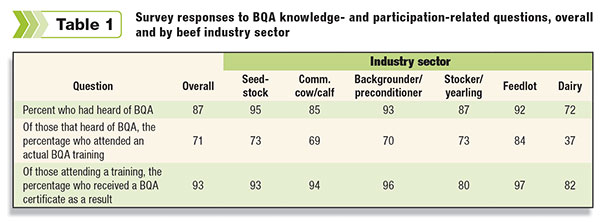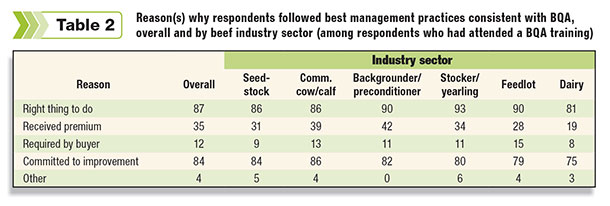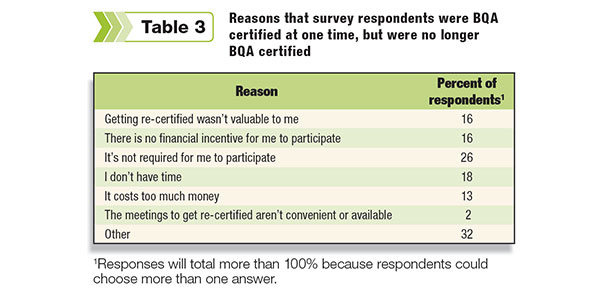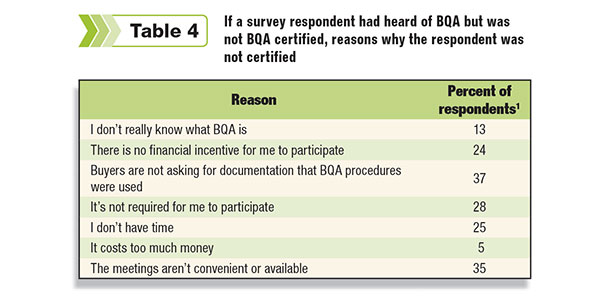The core structure of BQA continues to revolve around the “BQA certification” of cattle producers, which involves training producers about core BQA guidelines as they relate to the end products produced.
Currently, BQA is led nationally by the National Cattlemen’s Beef Association (NCBA) and implemented locally in states by university extension, state beef councils, state cattlemen’s associations and other similar organizations.
Previous analyses of BQA participation
The level of participation among cattle producers in the voluntary BQA program has been evaluated via several methods over time, more so than evaluations as to how effective the national BQA program has been at altering producer behavior to improve beef quality.
One of the first evaluations of beef cattle producer knowledge of BQA was conducted by the USDA National Animal Health Monitoring Service (NAHMS) via their 2007-2008 survey.
They reported 51 percent of beef cow-calf respondents had heard of BQA. However, only 22 percent of respondents who had heard of BQA actually attended a BQA meeting or training session.
Finally, 57 percent of producers who attended a BQA meeting were officially BQA-certified. Ultimately, this indicated that only approximately 5 percent of U.S. cow-calf producers were BQA-certified.
In 2006, the Joint Evaluation Advisory Committee of the Cattlemen’s Beef Board and NCBA requested an external review of the Beef Checkoff-funded national BQA program.
As a result, several white papers were generated by Drs. Barry Dunn, Ken Odde and Paul Genho after a series of interviews were independently conducted with industry leaders.
In these documents, the BQA program was commended for its extensive use of collaboration among diverse groups, a substantial reduction in injection-site lesions from 1991 to 2001, existence of BQA programs locally in nearly every state, the BQA certification of approximately 65,000 producers at the time and the “ability to educate a large number of producers about BQA in a relatively short time.”
However, these scientists also indicated the BQA program could not continue to rely on past accomplishments and redundant training materials, and that more standardization in core materials was needed in order to get more participation in BQA.
In 2011, Colorado State University surveyed all 50 states to document the presence (or absence), structure and success of BQA programs across the country.
State BQA coordinators (or a beef industry leader in that state, if a BQA program did not appear to exist) were asked to complete a 37-question online survey about their state’s BQA program.
Based on survey results, 45 active state BQA programs existed in the U.S. Based solely on estimates provided by respondents, there were 50,832 producers actively BQA-certified in the U.S. at the time the survey was completed.
Also based on pooled estimates provided by survey respondents, 72,539 cattle producers had been BQA-certified in the previous 10 years. It should be noted that many of these numbers were provided merely as estimates.
As part of the state BQA survey, a series of open-ended questions were asked of survey respondents, including possible reasons for each state BQA program’s success.
Responses were subjectively compiled to provide feedback about the status of BQA across the U.S. In response to the question, “In your opinion, what are the reasons for the success of your state’s BQA program?” responses generally fit into one of the following six reasons for success:
- Program structure – The strength of the national BQA program and sharing of materials among states, with trainings provided locally
- Industry support – Desire by cattle producers and organizations to locally support the state BQA program
- Role of university extension – The leadership provided by extension, including motivated BQA trainers funded almost entirely by universities
- Partnerships – Collaboration between university extension and industry organizations such as cattle associations and beef councils
- Training methods – Providing access to several BQA certification options, with many being hands-on in nature
- Market access – In some cases, BQA certification was required to participate in a special pooled, preconditioned or commingled feeder calf sale.
Reasons why producers participate in BQA
To more closely evaluate why producers participated (or didn’t participate) in BQA certification, a 43-question survey was developed for Phase III of the National Beef Quality Audit in 2011, which was led by CSU and Texas A&M researchers.
The survey was used to assess BQA-related production practices used by U.S. cattle producers and motivation to participate in BQA.
Surveys were completed by 3,755 cattle producers from 45 states, of which 74.8 percent were commercial cow-calf operators and the remaining were participants of other industry segments (seedstock, backgrounder/preconditioner, stocker/yearling, feedlot or dairy).
As seen in Table 1, 85 percent of commercial cow-calf producers that completed the survey had heard of BQA, of which 69 percent had attended a BQA training or completed one online. Based on the total number of respondents, approximately 43 percent of cow-calf operators were BQA-certified.
Of commercial cow-calf producers that attended a BQA training, 98.5 percent stated they followed best management practices consistent with BQA on their operation.
When those cow-calf respondents were asked why they chose to follow best management practices consistent with BQA, 86 percent indicated because “it was the right thing to do,” and 84 percent said because “I am committed to continuous improvement on my cattle operation” (Table 2).
Thirty-one percent responded that they chose to follow best management practices because they received a premium when they sold their cattle. Only 13 percent indicated that “the buyer of my cattle requires it.”
These results suggest that a financial reward tied to BQA certification is not necessarily essential for producers to participate in the BQA program.
The reasons that a respondent who was once BQA certified, but is no longer certified in a BQA program, were also evaluated (Table 3). A common reason why respondents did not continue to stay certified was that BQA certification was not required to participate in any programs.
Finally, reasons why respondents that had heard about BQA but had not become certified were also evaluated (Table 4). The predominant reasons were that buyers were not asking for documentation that BQA procedures were followed (37 percent) and the meetings weren’t convenient or available (35 percent).
Actual participation in BQA programs by commercial cow-calf producers (including formal BQA certification trainings and informal BQA education) is generally not known. However, it appears the majority of producers are aware of BQA at some level, but only a minority becomes BQA-certified.
Financial incentives are not necessarily required for producers to participate, yet the main reasons producers don’t become BQA-certified or choose to not become recertified are rooted in the lack of a requirement in the marketplace for BQA certification. ![]()
Jason Ahola is an associate professor of beef management systems with Colorado State University.
Editor’s note: The final reports of any of the surveys mentioned in this article can be obtained by contacting the author.











